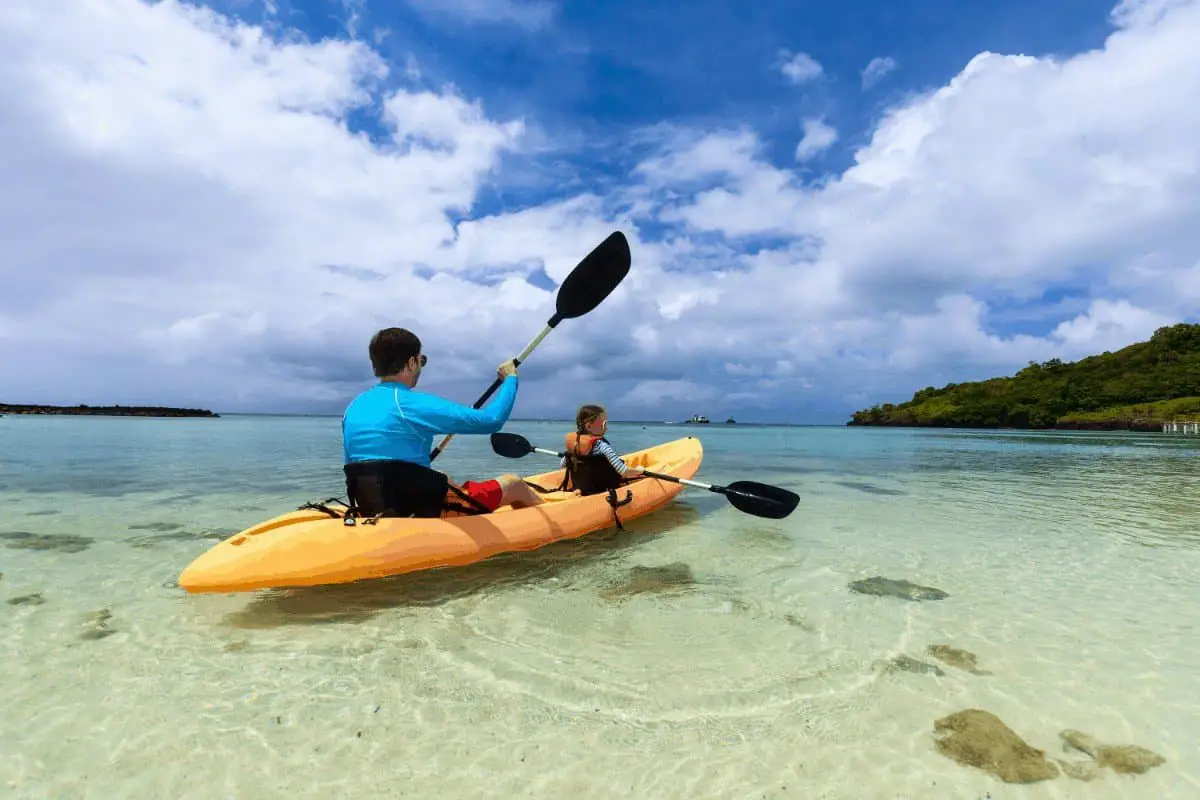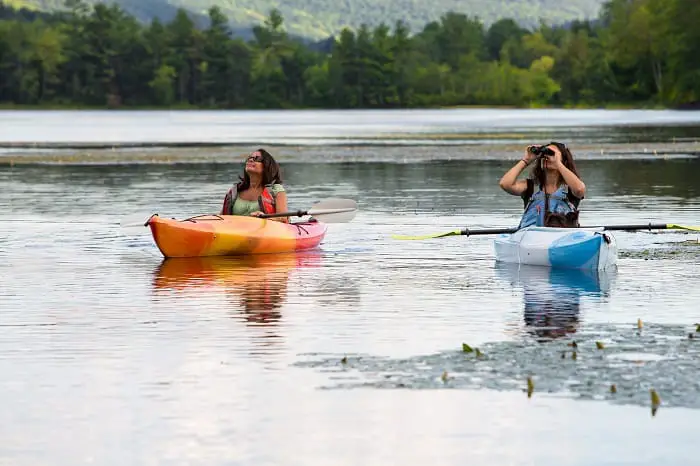Last Updated on July 7, 2022 by Ecorf
With kayaking gradually becoming mainstream in America, more and more people are delving into the enticing sport. But contrary to what most people believe, kayaking isn’t just about putting your kayak on water and paddling. There are many other things you should know about kayaking before you head off to the water.
It is a nice thing that you aren’t getting cocky by trying to go kayaking without some quick tips about kayaking. As a matter of fact, it is a smart thing for you to do. Many people end up getting themselves in situations where they could have avoided completely if they had simply known some of these tips.
Knowing and adhering to these tips are going to save you a lot of time and speed up your learning process. Although kayak experts are also welcome here, these are mainly kayaking tips for beginners.
Table of Contents
Short Guide to Choosing a Kayak
There are a lot of things to consider when faced with the tricky decision of choosing the best kayak for yourself. As a beginner, I would advise you to put the following things into consideration before picking out a kayak for yourself.
Stability
You don’t want to keep falling into the water every time you rock the kayak or hit the smallest obstacle. Stable kayaks are suitable for navigation in rough waters, and usually, the flatter kayaks are more stable.
Material and Durability
As a beginner, it is very possible that you suck at steering the kayak and you keep hitting that innocent thing against this and that. That is why you should consider getting a kayak that can withstand as many hits as possible without stress. There are basically 7 materials that you can choose from; Kevlar, inflatable plastic, hard plastic, carbon fiber, fiberglass, wood, and fabric with a frame.
Depth and Width
The depth and width of the kayak are good factors to consider if you would be needing extra storage space on the kayak. Deep kayaks are often perfect for bigger people who need enough space to comfortably fit into. The width of the kayak also contributes to it stability but there would be a compromise on the speed.
Length
The length of the kayak comes into play when you’re weighing speed against easy maneuverability. The longer kayaks move faster on water than the shorter ones while the shorter ones have a maneuverability edge.
Going straight to the tips
Tip #1: Take Kayaking Lessons
Don’t assume you already know how to kayak just because you watch people doing it. As a matter of fact, there are many things that you really should learn before heading out to the water. Paddling techniques, right sitting positions, safety tips, and many more things lessons like these could save you a lot of trouble on water.
Tip #2: Don’t Get Cocky
As far as I know, kayaking is meant to help you have some fun, not get you to challenge nature. No matter what you do, the water is still nature, and nature is not only unpredictable, but also uncontrollable. Don’t go kayaking where you could get hurt. If you don’t have enough skill to kayak in a particular water body, do not even dream of kayaking on it.
Tip #3: Know Your Paddling Techniques
As you might have already guessed, paddling isn’t all about just dipping either end of the paddle into the water one after the other. Even if you got your kayak moving, you might find out that you are expending more energy than you should. The paddling techniques are there to help you paddle on different water bodies for a long time, and with as little stress as possible.
Tip #4: Dressing for the Water
A common mistake beginner ‘yakkers often make is to pick their dressings because of the weather. When kayaking is involved, the water should be the deciding factor of whatever it is you should wear. As a matter of fact, you might need a swimsuit much more than you know.
Tip #5: Learn Safety Techniques
Your safety on the ocean is largely dependent on you. When going in a kayak expenditure, you really should know what you should or shouldn’t do to avoid trouble on the water. Also, you should know how best to get yourself out of trouble if you find yourself in any.
And always remember: safety first.
Tip #6: Buy the Right Equipment
Buying the right set of kayaking equipment would save you a whole lot of trouble and stress. Check out guidelines for choosing the best gear for yourself before going out to buy those gear. You could also rent some of this equipment initially to know which one you are most comfortable with.
Tip #7: Know the Kayak Language
The waters could get noisy a lot of times, effectively deafening you even to the sound of your own breathing. That is why there are hand signals and gestures that kayakers use to communicate with one another on water. This way, you could get a heads-up about where you are heading from someone who was just there.
Tip #8: Get Yourself a Map
Getting lost on the ocean is a very easy thing that could be done without stress, trust me. For this sake, you would need to get yourself a map helps you pinpoint where you are, where you’re coming from, and where you are going to. You could also use the map to avoid some troublesome parts of the waters.
Tip #9: The Weather Forecast is Your Friend
You would be fine if there were just light drizzles of rain while kayaking. In fact, it is a wonderful experience. However, things could quickly get horrible if it begins to rain heavily.
Heavy rainfall could sink you kayak faster than you know. It could either fill up your cockpit or make the water more turbulent. Trust me, you really want to avoid these situations, especially if you are not a skilled ‘yakker.
That is why it is important to familiarize yourself with the weather of not just the day you are going to kayak, but also some days before. This way, there would be no mischievous surprises from nature.
Tip#10: Sit Properly in Your Kayak
You need to learn to seat properly in your kayak. Your seating posture could affect your stability.
Relax into your seat while placing your feet properly on the foot guide or pegs. Your heels should align with the center of the kayak while your toes should be pointing outwards.
Tip #11: Don’t Go Faster than Yourself
Chill out. You don’t have to speed all through the experience. Take time to enjoy the scenery and all some cool ocean breeze to spoil you. Trying to go too fast could quickly tire you out, especially if you don’t have the help of the water currents.
Tip #12: Stay Alert, Stay Sharp
You don’t want to be surprised by animals, rocks or obstructions that just seem to pop out of nowhere on the water. You should keep your eyes open at all times. You can’t afford to be distracted.
Tip #13: Do not Isolate Yourself
As mentioned earlier, there are hand signals with which you could communicate on water. These signals wouldn’t have been invented if it wasn’t necessary to communicate with other kayakers. As a matter of fact, it is advisable to kayak in groups.
Tip #14: Come Along with Your Binoculars
There are sometimes where you want to look far ahead of where you are. It could be to check out some wildlife far away on the shore or to see where you are going. Whatever it is, a good sight enhancement is really welcome.
Tip #15: The Duct Tape Always Helps
I guess you would agree with me if I said that duct tapes have been saving lives since the days of the dinosaurs. It is a quick solution to cracks and keeping some equipment in place.
Tip #16: Learn to Take Care of Your Kayak
Suffice to say, proper maintenance of your kayak and other gears would make sure they last long. When you are done kayaking, clean and dry your equipment. You can’t afford to be nonchalant or lazy about this.
Wrapping it All Up
Remember, your safety is much more important than any other thing when you are kayaking. Even that really expensive kayak that you own isn’t worth half as much as your life. For this reason, make sure you do everything you could possibly do to keep you from getting into some ugly situations.
Having said that, you could learn how to get yourself out of some of these ugly situations if you unavoidably find yourself facing any. I really hope that these tips are of help to you and that they help you to have much more fulfilling kayaking experience.
Feel free to place your comments, inquiries or questions in the comment section below. Happy kayaking.





